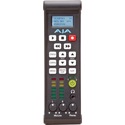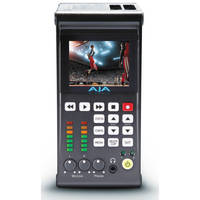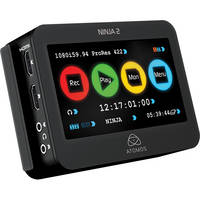Media & Computing: External Recorders
 |
AJA Ki Pro Mini Compact FIeld Recorder | B&H | Mfr. Site | |
|---|---|---|---|---|
|
Comments: This is one of the best solution right now for converting your footage on the fly into ProRes in a small package that you can mount on any camera rig. Description: The Aja Ki Pro Mini Compact Field Recorder adds extreme portability to the Ki Pro family. Bringing a file-based workflow to any production to be edited on Final Cut Pro, this miniature field recorder not only records edit-ready Apple ProRes footage from any SDI or HDMI video camera, it does so on easily available Compact Flash cards. Its small form factor allows it to be mounted on a tripod or camera with industry-standard adapters, while its powerful support of both SD and HD recording–via both SDI and HDMI–makes it an invaluable tool for on-set digital capture. |
||||
 |
AJA Ki Pro Quad | B&H | Mfr. Site | |
|---|---|---|---|---|
|
Comments: Same as a above and a leading 4K solution – Notably w/ the C500. Description: The AJA Ki Pro Quad 4K Solid State Recorder ingests raw footage from a camera, and performs up to all three of the following functions simultaneously: stores the footage to an SSD, transfers the footage to a RAID or Thunderbolt-enabled computer, and outputs the footage to up to two displays for monitoring. Footage can be captured RAW and in 4K, Quad HD, 2K, and HD resolutions. Captured RAW, it can be transferred RAW to a RAID or computer. Color depth supported is 10-bit 4:4:4 and 10-bit 4:2:2. In cases of storing to an SSD, the Ki Pro Quad can record in 4K, 2K and HD ProRes formats, which are friendly to Final Cut, Premiere and Avid. Two SSD slots are available. |
||||
 |
Atomos Ninja 2 | Buy From B&H | Rent From LensProToGo | Mfr. Site | |
|---|---|---|---|---|---|
|
Comments: This is a SECRET weapon. Why? Basically all DSLRs heavily compress your video. That video is hard to process due to the compression when you use most video editing software. This unit takes a clean signal from the 5D MKIII for example and DOESN’T compress it – instead it goes straight to ProRes 422 or AVID DNxHD. I power these with my LPE-6 batteries (The 5D MKIII batteries) and the unit can start and stop recording automatically when you hit record on your 5D. Definitely recommend you look into these instead of CF cards and compressed workflows – you can mount these on the hot shoe of your camera and run! Description: The Atomos Ninja 2 Video Recorder is an HDMI recorder and 800 x 480 resolution monitor that records up to 1080/30p/60i resolution directly from your camera’s sensor to an HDD or SSD in Apple’s ProRes or Avid’s DNxHD edit-ready codecs. Color precision records at 10-bit, even from an 8-bit sensor, and color sampling at 4:2:2. Recording an 8-bit signal in 10-bit won’t increase the quality of the signal but will let you work with the signal in post-production as if it’s 10-bit, meaning you can add effects and not see jagged lines and other artifacts. Being able to record direct from the sensor lets you bypass your camera’s compression and instead have the first compression be in an edit-ready codec. Generally, the less compressions, the less image degradation. |
|||||
 |
Samurai Blade 5" | Buy From B&H | Rent From LensProToGo | Mfr. Site | |
|---|---|---|---|---|---|
|
Comments: This is a SECRET weapon. Why? Basically all DSLRs heavily compress your video. The C-Series and other cameras that record internally do as well. That video is hard to process due to the compression when you use most video editing software. This unit takes a clean signal from any of these cameras and DOESN’T compress it – instead it goes straight to ProRes 422 or AVID DNxHD. This is very similar to the Atomos Ninja but with quite a few upgraded features such as a much larger monitor, scopes and waveform, as well as HDSDI inputs. Description: The Atomos Samurai Blade 5" SDI Monitor & Recorder features a 1280 x 720 resolution monitoring display, substantially better than that of the original Samurai’s. Like the original, Blade can record up to 1080/30p/60i resolution directly from your camera’s sensor to an HDD or SSD in Apple’s ProRes or Avid’s DNxHD edit-ready codecs. Color precision records at a high 10-bit, even from an 8-bit sensor, and color sampling at 4:2:2. Recording an 8-bit signal in 10-bit won’t increase the quality of the signal but will let you work with the signal in post-production as if it’s 10-bit, meaning you can add effects and not see jagged lines and other artifacts. Being able to record direct from the sensor lets you bypass your camera’s compression and instead have the first compression be in an edit-ready codec. Generally, the less compressions, the less image degradation. Blade has an SDI input for ingesting from a camera and an SDI loop-output for simultaneously looping out the camera signal to a large SDI monitor up to 300 ft away. You can also ingest by HDMI through an optional Atomos SDI to HDMI converter. Blade supports all cameras for monitoring, even 4K and 5K cameras like RED’s Epic and ARRI’s Alexa, and can successfully record 1080/30p/60i from most cameras. |
|||||












